Continuing with more of Lieutenant General Hendrik George de Perponcher-Sedlnitsky’s 2nd Netherlands Division in the Hundred Days campaign here we have my recreation of (Major-General) Willem Frederik count of Bijlandt’s (or Bylandt) 1st Netherlands Brigade; following on from the 2nd Nassau-Usingen Regiment and the 28th Oranien-Nassau (Orange-Nassau) Regiment of von Sachsen-Weimar’s (Saxe-Weimar) 2nd Netherlands Brigade. So here’s some more ‘Work In Progress‘ type photos as I work on basing these chaps ready for service on the table top…
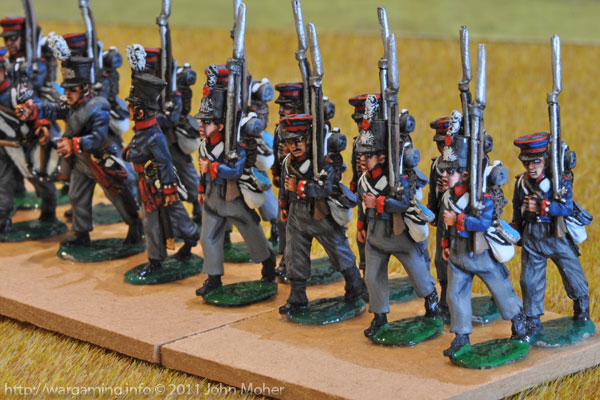
7th (Belgian) Line Battalion (Regiment) – this was the only regular line battalion (and one of only two regular battalions) in the brigade, and numbered around 700 men – in Lasalle terms it’s at the upper end of the standard sized unit (4-bases) but not quite large enough to warrant being classed as large (6-bases). I have done 2 Skirmisher Stands for this unit as it’s debatable whether it warrants 1 or 2 so I have erred on the safe side (i.e. whether it’s skirmishing ability was as good as the French & British battalions which get 2 skirmishers, or should be less so only 1). Like all my Quatre Bras Dutch-Belgian-Nassau-Brunswick forces these chaps are all Perry Miniatures and were commission painted by Dragon Painting Services in Hong Kong, and I originally had units of 16 figures for Shako II, but had to enlarge the units from 16 to 24 or 36 plus skirmisher & casualty markers.
27th (Dutch) Jäger Battalion (Regiment) – The 27th Jäger were a fairly large unit (over 800 men) so warrant representation as a large unit (6-bases) in Lasalle. I have also modelled 6 Skirmisher stands for them to allow for the whole battalion being broken down into companies to reinforce the skirmishers of the other battalions. Like the 2nd Nassau-Usingen Regiment this is one of my favourite ‘Hundred Days‘ units, again perhaps due to a mix of the uniform’s colours & appearance, and the life in the Perry Miniatures figures, such as the officer brandishing a flintlock pistol, expressions on many of the Jägers’ faces, etc…
5th, 7th, & 8th (Dutch) Militia Battalions – The balance of General Bijlandt’s Brigade was made up of 3 Netherlands Militia (or Landwehr) Battalions, drawn from the North Netherlands (i.e. Dutch), these varied somewhat in uniform & appearance, size, and quality but generally performed well at Quatre Bras considering their lack of training, etc. There is rather patchy information around their appearance, equipment, and performance, but I have modelled them as mostly figures in British supplied (stove-pipe) shakos, with just one battalion (I’ve chosen the 8th) having a mix of about 2/3 field caps and only 1/3 in shakos for variety. The 7th & 8th Battalions were fairly large (approximately 675 & 570 men respectively) with the 5th being a little smaller (about 480 men) so all three were comparable in size to many of the regular French & British battalions and standard sized units for Lasalle, and feature just one skirmisher stand each as they only had a small number of men trained for skirmishing (and the level of training is questionable).
I might need to touch up the shako cockades on the militia as they should be more orange than red – being supposedly the Netherlands’ National Colours.
On a final note there is a great site with some interesting information specifically about the 8th Dutch Militia and Sergeant Evert Roelof at the battle of Waterloo – it includes useful uniform information about all 3 Militia Battalions and details of their history.
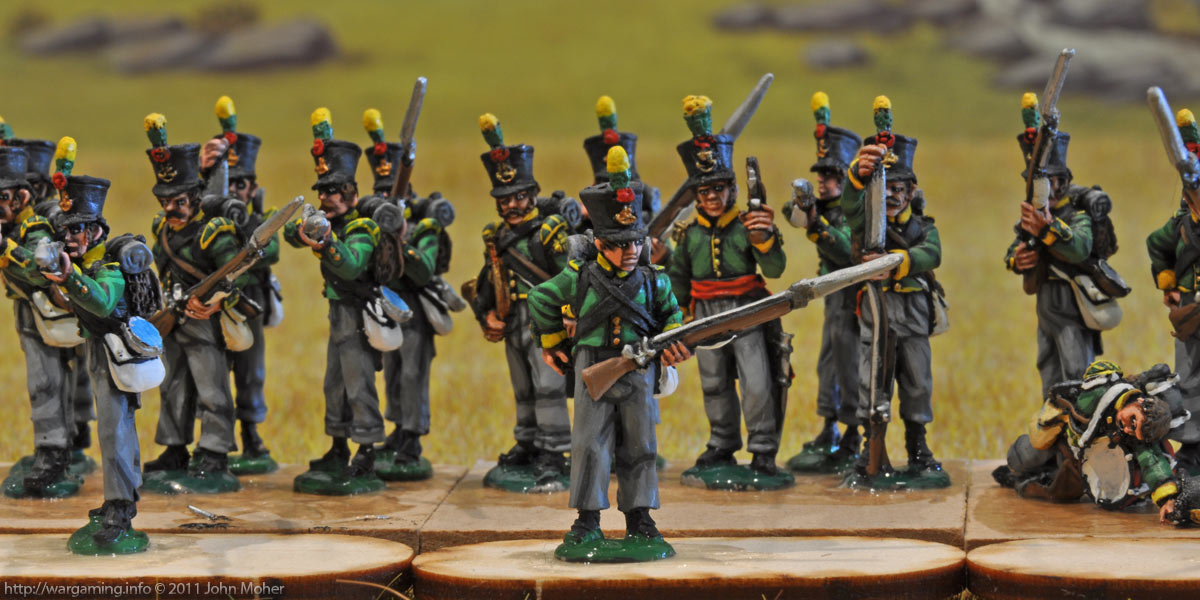
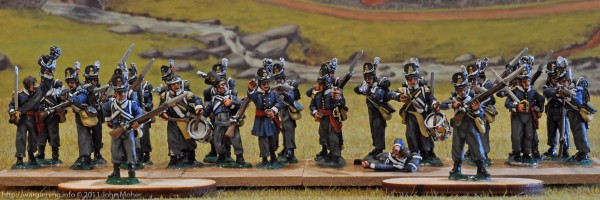
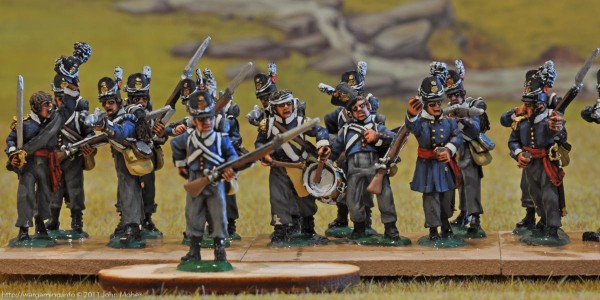
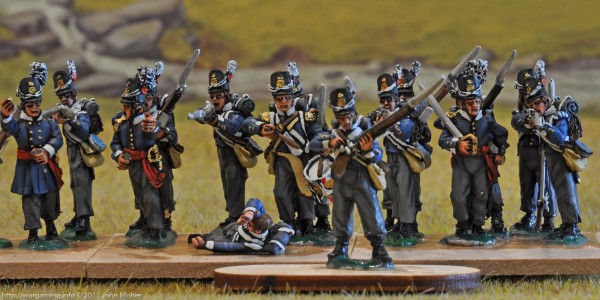
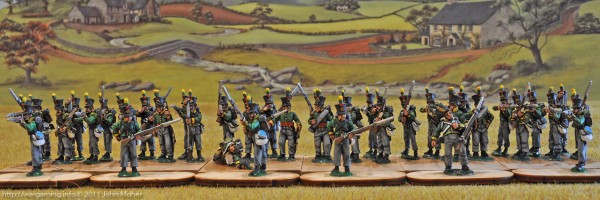
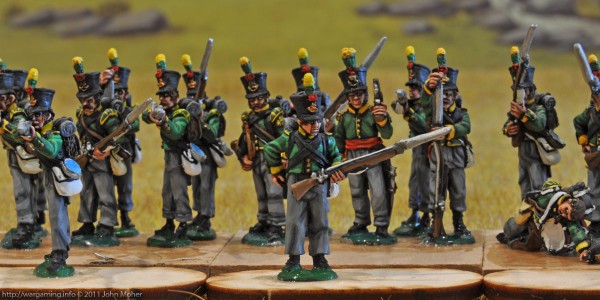
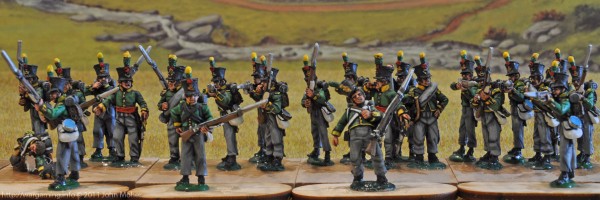
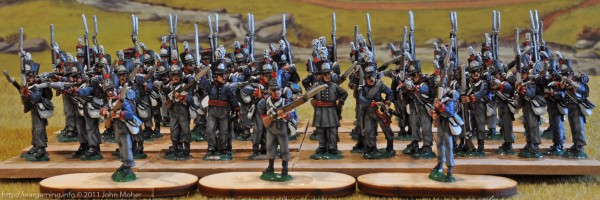
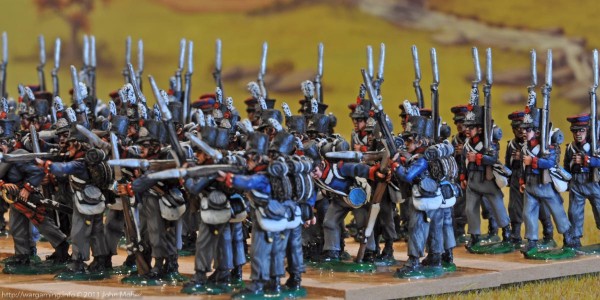
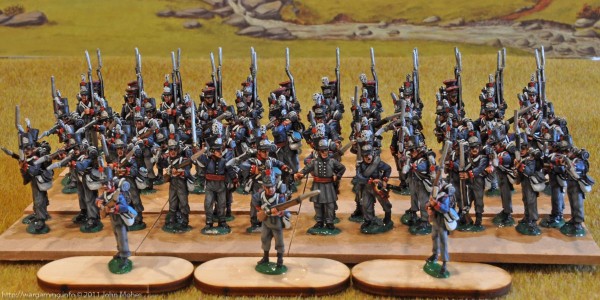
Nice one. Only one tiny bit of critique: The Dutch army was well dressed and equipped, so there is no reason to have them depicted with different headgear and such. The Prussian style field cap had not been introduced yet, as the Dutch type of fatigue cap was made of calfs leather, acoording to 1813-1814 regulations. Also the lack of training is somewhat debatable: most officers in the Dutch and Belgian armies were battle hardend
veterans that had seen action in Spain, Russia and Germany when fighting
in the French army. As for the rank and file: the website about the 8th Militia -a conscript unit, as opposed to the Line and Jagers which were volunteer units,- shows that this unit for instance was made up of about 60% veteran volunteers. I also looked at the muster book of the 7th line, this unit also had a lot of veterans in the ranks. The 7th line was a volunteer unit, with many foreigners (including 2 Americans and one Jamaican!). You are right about the flanker units though: the 27th Jagers had little experience as light infantry. and the flank companies of other units were untrained to act as skirmishers, -even though they were sent out for that task on more than one occasion.
Keep up the good work, it looks amazing!
Hi Marc,
Thanks for the compliments and the comments – I always appreciate any new information on the Netherlands’ forces – Are you saying that (a) the Dutch Militia all would have definitely had Shakos, and (b) that even if they had worn the Fatigue Cap in battle the Perry’s have modelled the wrong type for the Dutch Militia (i.e. the post Waterloo one)?
Regarding experience I for one certainly don’t doubt the Dutch & Belgian troops weren’t of reasonable quality – I have regularly argued that blindly categorising all such Militia & Landwehr, and such like, troops as “2nd Line” or “Shaky” or whatever isn’t very scientific. I certainly think the above brigade at Quatre Bras performed admirably, and some of the units were effectively in the line for quite some time. However with some rules systems the gradings are so coarse (such as in Lasalle & Shako II with only 3 levels) there isn’t much choice – In Lasalle I currently favour probably rating the Militia as Reliable/Amateur – this recognises they have reasonable numbers of Veterans included, etc, (not just a small cadre), but they may not be the best drilled formations due to their newness, etc – which I think is (in Lasalle terms) a fair rating when British (& French) Regulars are rated just a fraction higher at Reliable/Experienced and the Brunswick Line & Light battalion raw recruits significantly lesser at Shaky/Amateur.
Regarding Flank Companies – yes I seem to be finding more and more evidence they struggled seriously against the French Voltigeurs, and while making brave efforts were generally unable to hold their ground much of the time…
Appreciate the positive feedback – and any further historical detail you may be able to provide on the troops in Bijlandt’s force…
Cheers,
John
Re. 8th Dutch Militia, 61% was raw, 39% were experienced men, some with long histories in the military service. Though what “experienced” means is unknown – Colonel deJong was an old French veteran, but going through the list of soldiers’ previous service relatively few had previous French service (mostly with the garde nationale or marines).
How would that rate differently from a Prussian landwehr unit, or a Hanoverian landwehr uinit?
How would that rate differently from a Prussian landwehr unit, or a Hanoverian landwehr uint?
That my friend is the million dollar question and whether there is any difference – and/or what the difference is between them and Regular units like the Brunswick Line & Light Btns, and by comparison to some of the later (1812-1813) new Confederation of the Rhine Regulars and similar too. Also how you interpret the casualties and such, at both Quatre Bras and Waterloo, as indicators of how heavily involved they were in combat, etc, and how that should or should not influence ratings…?
🙂